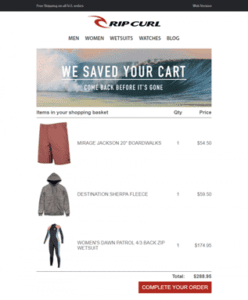Tips and techniques for improving customer satisfaction and increasing conversions for a healthier bottom line
Shopping cart abandonment occurs when potential customers add items to their online shopping cart but exit the website without completing the purchase. And it’s more common than you might think. According to the Baymard Institute, about 70% of all carts are abandoned. Now, that’s a huge chunk of change! And if history is any predictor of the future, cart abandonment rates will continue to rise.
While shopping cart abandonment can be a sign that there’s a problem in your checkout process or in the architect of your cart, it’s also a great opportunity to get more information about your shopper and reengage. Also keep in mind that not all abandonment is bad — we’ll explain more later how the cart has become a useful tool for shoppers.
Cart Abandonment Solutions: Common Reasons for Abandoned Carts
Every abandoned cart represents a product or collection of products that could have been sold, a customer who could have been satisfied, and a relationship that could have been nurtured. Understanding cart abandonment is crucial for developing an effective strategy to encourage customers to complete their purchases.
Some abandoners fully intend to return to their cart and complete the purchase process; their items are stored in their cart for safekeeping. The remaining abandoners leave because of underlying issues in your shopping process, such as complex navigation, unexpected costs, problems with shipping, or limited payment options that keep them from completing their purchase.
The top reasons for cart abandonment globally are delivery options, payment options, lack of clarity at checkout, problems with the return policy, security problems, and mandatory account creation.
There are a variety of other reasons. For instance, maybe the shopper is just window shopping and has no plans to buy right now. Maybe they found higher-than-expected prices or were surprised by the mounting fees and taxes. Or maybe something about your checkout concerns them about fraud, data privacy, or data security. Are you mandating account signup or forcing email subscriptions? These things can be a big turnoff and cause even the most stalwart to leave their cart at the curb.
Failure to effectively tackle cart abandonment can result in a poor customer experience, and diminished customer satisfaction and loyalty, ultimately affecting the long-term success and competitiveness of your business in what has become a crowded online marketplace.
Techniques to combat cart abandonment: Remediation and recovery
Although it’s impossible to eliminate cart abandonment, there are some very effective tactics to limit its occurrence and get abandoners back to their cart to complete the purchase. Let’s break them down.
1. Personalized shopping experience.
Streamline and tailor the customer journey. Effective methods include:
- Offer relevant product suggestions to help them quickly find what they need.
- Use social proof to foster trust and reduce purchase anxiety.
- Introduce dynamic content such as countdown timers, special offers, and exit-intent pop-ups to create a sense of urgency.
2. Detailed product information.
Online shopping lacks physical interaction with products, which makes detailed descriptions essential. Features like 360° videos and virtual dressing rooms help consumers visualize the product and increase their confidence in the purchase.
3. Seamless customer experience.
Make sure your shoppers’ experience, from browsing to final purchase, is intuitive and seamless across devices. According to Statista, 85% of mobile shopping carts are abandoned. Check your mobile cart abandonment rates and then look for areas for improvements.
One possible area for improvement is payment options. The No. 2 reason shoppers say they abandon their carts is limited payment options: 58% want multiple payment options at checkout. In addition to credit cards, include UK shoppers’ preferred alternative payment methods, Klarna, PayPal, and MyBank.
Once you’ve done all you can to improve the mobile UI, try adding an exit-intent popover offering the shopper to send them an email containing their shopping basket.
Feel Good Contacts gives shoppers this option along with a 10% discount to incentivize them to complete their purchase — all the shopper has to do is provide their email address, return to the cart, and buy.
4. Flexible shipping options.
Evaluate whether your shipping choices are convenient for online shoppers while still being competitively priced. According to Statista, delivery is the No. 1 reason worldwide that shoppers abandon their carts.
Reasons include:
- Shipping isn’t FREE.
- Shipping costs are too high or are listed too late in the process.
- Delivery takes too long, or timing isn’t provided.
- The recipient’s address can’t be validated.
- Limited choice of delivery services.
Free shipping is a biggie. After years of using free shipping to convince consumers of the convenience and cost-effectiveness of shopping online, merchants are now forced to scale back on free shipping because of the rising expense and negative effect on margins. In 2022 and 2023, high shipping costs were merchants’ No. 1 concern.
Merchants may be ready to let go, but shoppers are even more attached than before: 62% (up from 52% in 2022!) of shoppers won’t buy from an eCommerce company that doesn’t offer free shipping. That’s not a showstopper because 47% said they are willing to meet free shipping thresholds.
Give them the free shipping they want while increasing your AOV. Using an AI-powered personalization engine, suggest related accessories or complementary products to help your shopper meet your free shipping threshold. Base the recommendations on your shopper’s preferences or behavior or items others have also bought. Pair recommendation rules with business rules such as high margin or overstocked.
5. Retarget on social media.
Just because the shopper has stepped away from their cart doesn’t mean they don’t want those items. Maybe they got distracted by soccer practice or a work meeting. Or maybe they are scrolling through social media. Bring them back to their cart by retargeting them with Facebook and Twitter ads tailored to their carting behavior using Facebook and Twitter Custom Audiences.
6. Triggered recovery emails.
Even when the shopper has left your website, the sale isn’t necessarily gone for good. Highly personalized triggered emails can turn the tide. Together with Censuswide, we polled 2000 consumers across the UK to learn what marketing tactics are most likely to bring them back to their abandoned shopping carts. Here’s what they told us:
- Nearly 50% said an email telling them that a product in their cart had dropped in price would encourage them to return to their shopping cart. Now’s a good time to implement triggered price drop emails.
- 45% would return to their cart if they received an email with a discount code for the items in their cart. Now’s a good time to think through your coupon marketing strategy and possibly add a discount code to your triggered cart recovery email campaign.
- More than 25% say an email listing the items in their cart would encourage them to return, so make sure you’re sending timely cart abandonment emails that include the details and images of the carted products.
- 1 in 5 consumers would go back to their cart after getting an email informing them that items in their cart are in short supply. Try adding scarcity messaging to your cart recovery emails or send low-in-stock emails.
- Finally, 15% of shoppers would return to a retailer’s website after receiving an email with recommendations for products similar to what they had added to their cart. Test personalized product recommendations in your cart recovery emails to see if it’s the right tactic for getting your shoppers back into the buying mood.

As marketers, we worry that our emails are a nuisance. No need to worry. As you can see, busy shoppers find the triggered emails useful. And, we’ve found that sending a multi-step cart recovery campaign is even more successful than sending one — the multi-step campaign generates 21% more sales uplift than a single cart recovery email.
Having techniques in place to get shoppers back to their carts is great but it would be even better to make sure they never abandon in the first place.
Preventing abandoned carts in the first place
While it’s impossible to prevent abandoned carts, it is possible to reduce the instance of abandoners. Reducing cart abandonment is crucial for eCommerce businesses, marketers, and website managers aiming to maximize sales, customer satisfaction, and retention. It increases conversion rates, boosts revenue, improves customer experience, and provides insights for better services and product offerings.
Here are six things you can do to smooth the path to checkout:
1. Provide guest checkout options: Requiring account creation can be a hurdle for many customers. Offering a guest checkout option can streamline the process and reduce abandonment.
2. Apply a special offer within the cart: Incorporating special offers or discounts directly in the cart can encourage customers to proceed with their purchase.
3. Offer several payment options: Providing a variety of payment methods, including digital wallets and alternative payment platforms, can cater to a broader audience.
4. Show clear calls to action: Clear and prominent calls to action (CTAs) guide customers smoothly through the buying process, reducing the likelihood of abandonment.
5. Provide a choice of delivery options: Offering multiple delivery options, including faster shipping for an additional fee, can cater to a variety of customer preferences.
6. Show a persistent reminder of cart contents: Displaying a visible reminder of the items in the cart, such as a cart icon with a number or a dropdown preview, can keep the products on the customer’s mind.
Conclusion
Cart abandonment is a complex issue that can be effectively addressed with the right strategies. By understanding the reasons behind abandonment and implementing solutions such as optimized website navigation, targeted recovery tactics, and diversified payment options, businesses can reduce cart abandonment.
The key is to create a seamless, enticing shopping experience that guides the shopper from browsing to buying. With these solutions in place, eCommerce sites can turn potential losses into successful sales, enhancing both customer satisfaction and business profitability.






